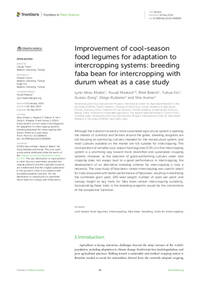Improvement of cool-season food legumes for adaptation to intercropping systems: breeding faba bean for intercropping with durum wheat as a case study

Authors:
Although the transition toward a more sustainable agricultural system is sparking the interest of scientists and farmers around the globe, breeding programs are still focusing on optimizing cultivars intended for the monoculture system, and most cultivars available on the market are not suitable for intercropping. The incorporation of versatile cool-season food legumes (CSFLs) in the intercropping system is a promising way toward more diversified and sustainable cropping systems. However, as the selection of good-performing cultivars under sole cropping does not always lead to a good performance in intercropping, the development of an alternative breeding scheme for intercropping is now a necessity. The case study of faba bean–wheat intercropping was used to select for traits associated with better performance offaba bean, resulting in identifying the combined grain yield, 100-seed weight, number of pods per plant, and canopy height as key traits for faba bean–wheat intercropping suitability. Incorporating these traits in the breeding programs would be the cornerstone of the prospective transition.
